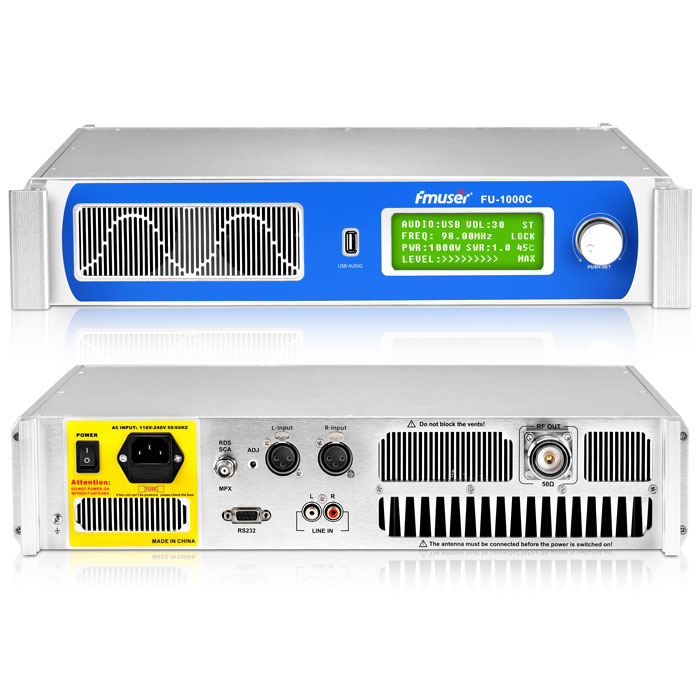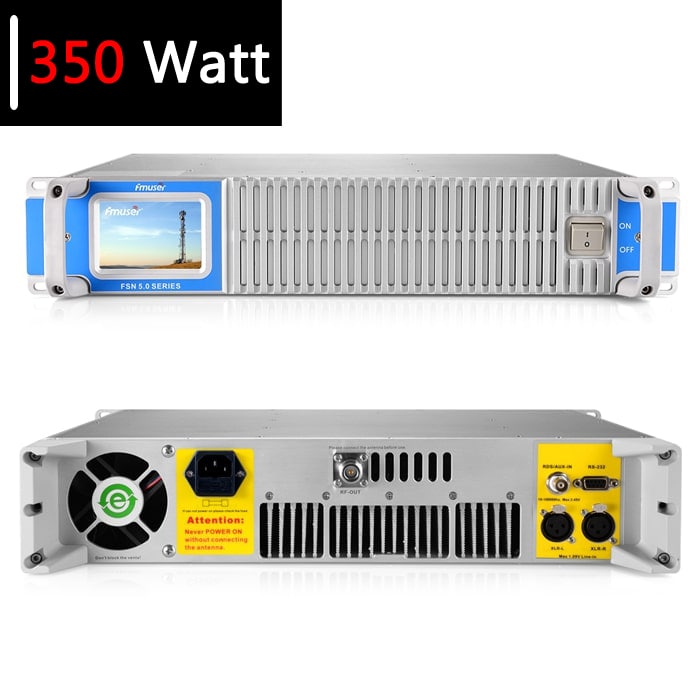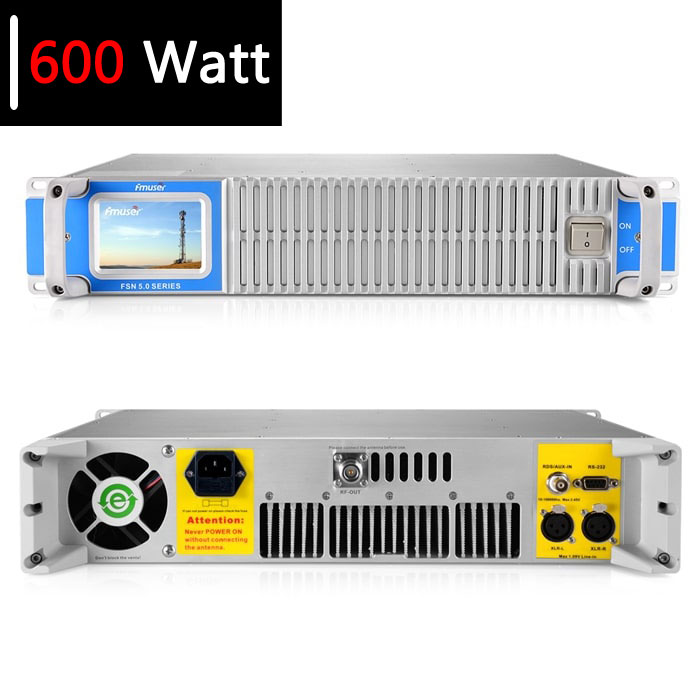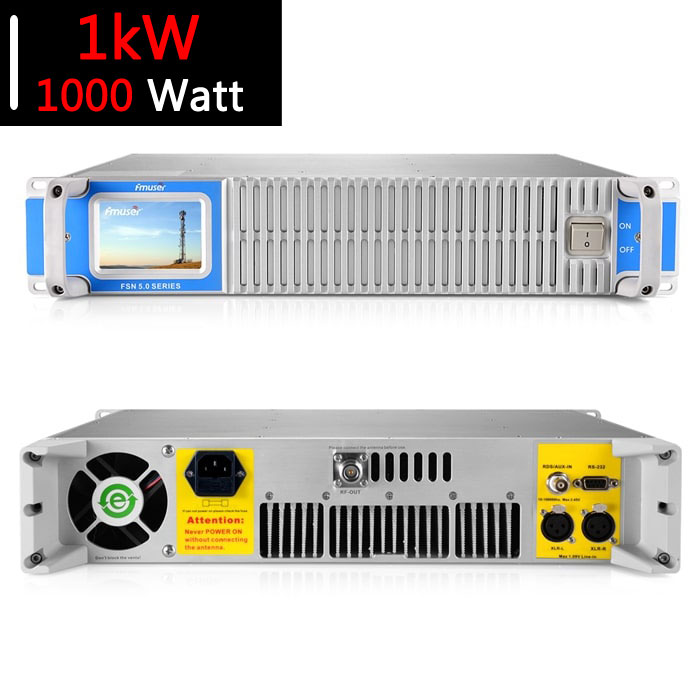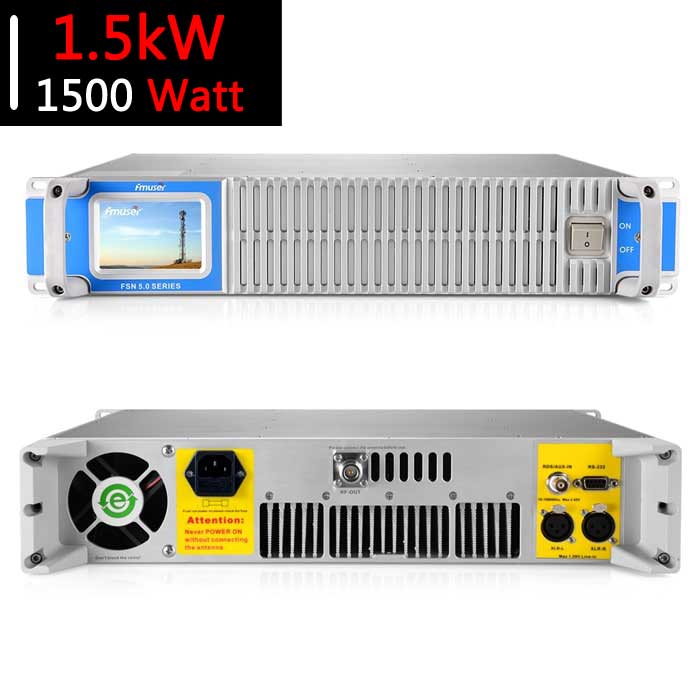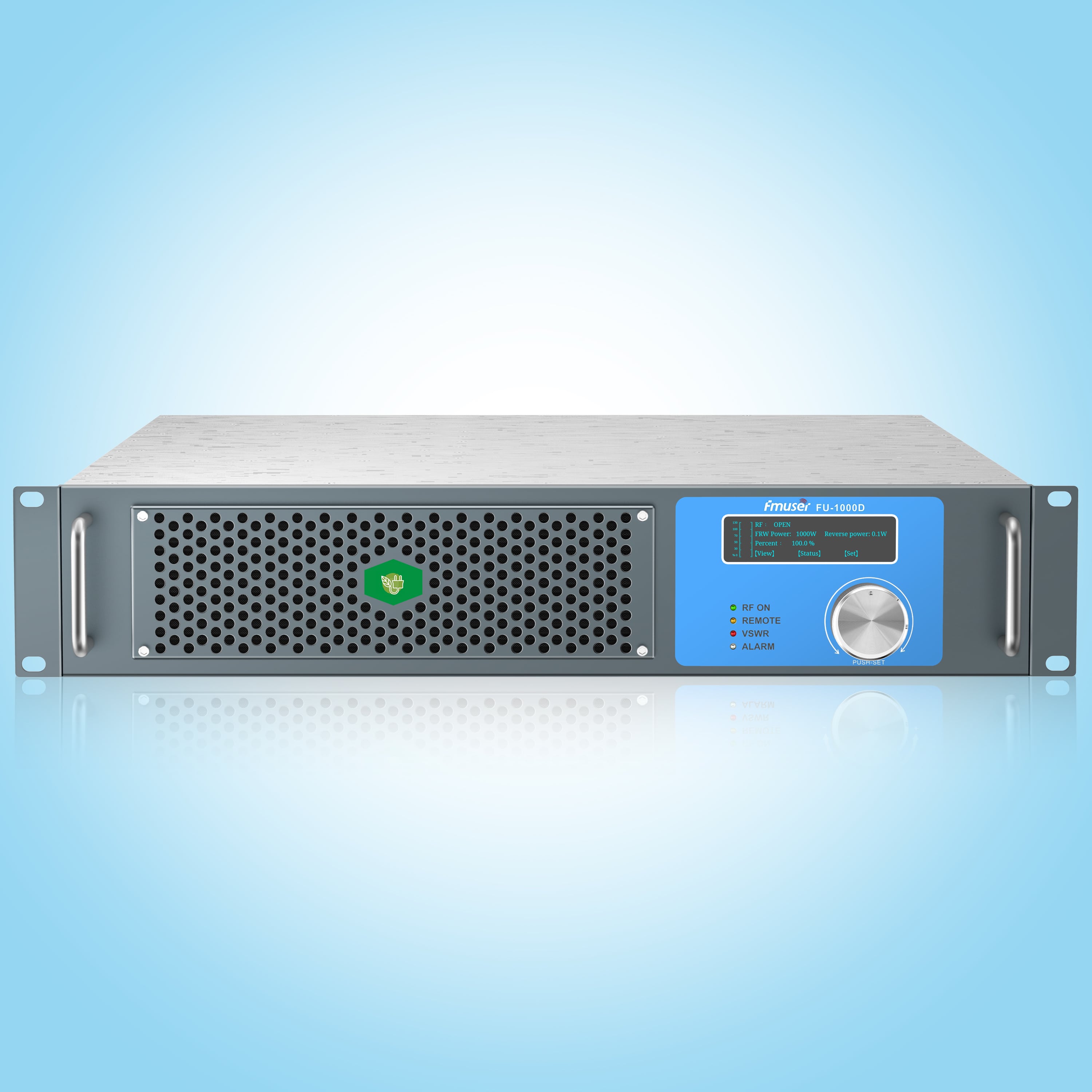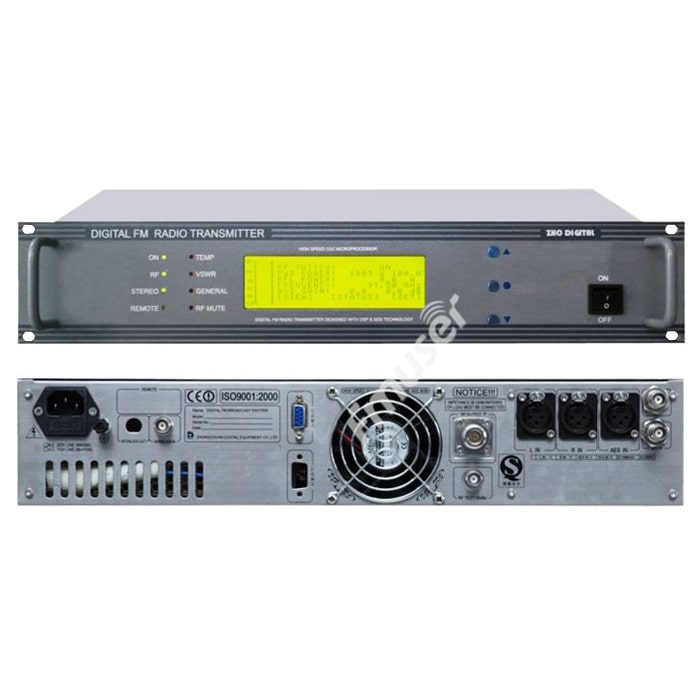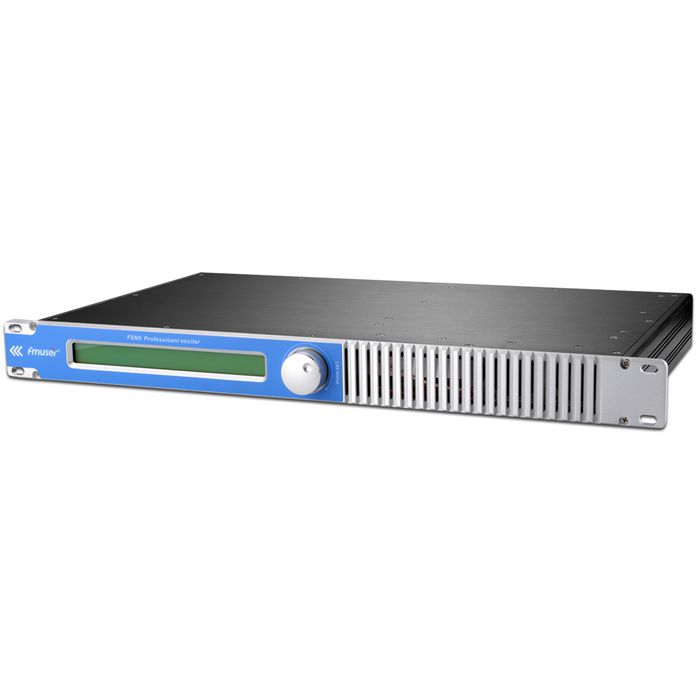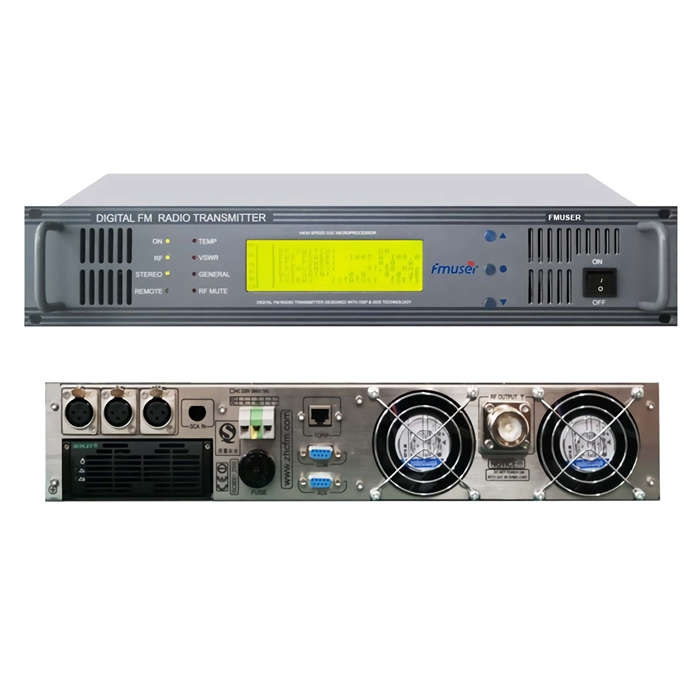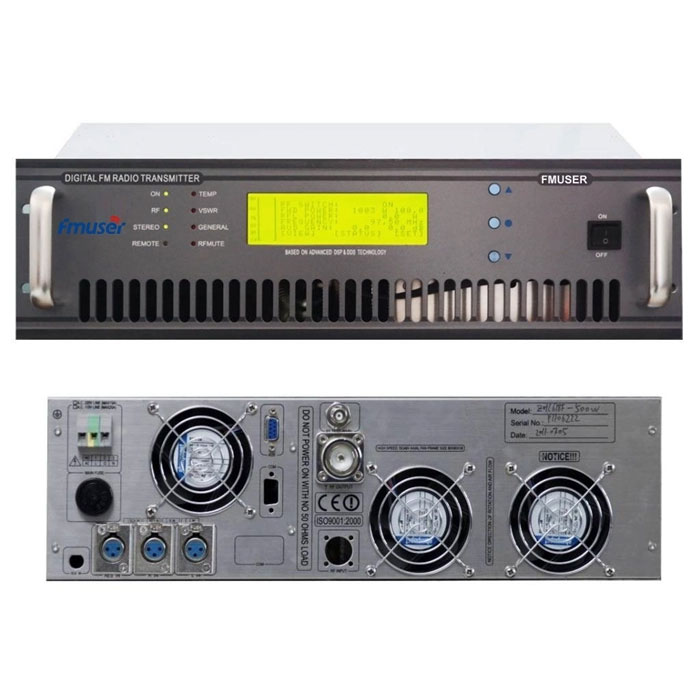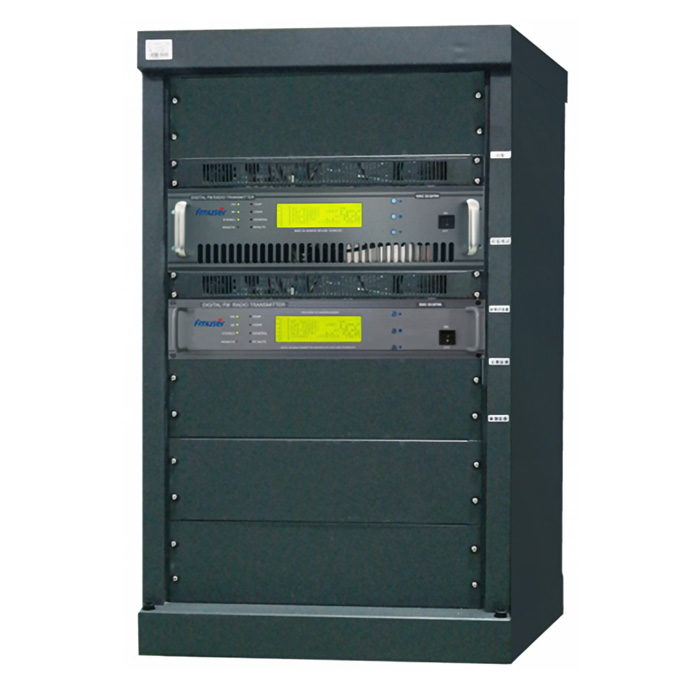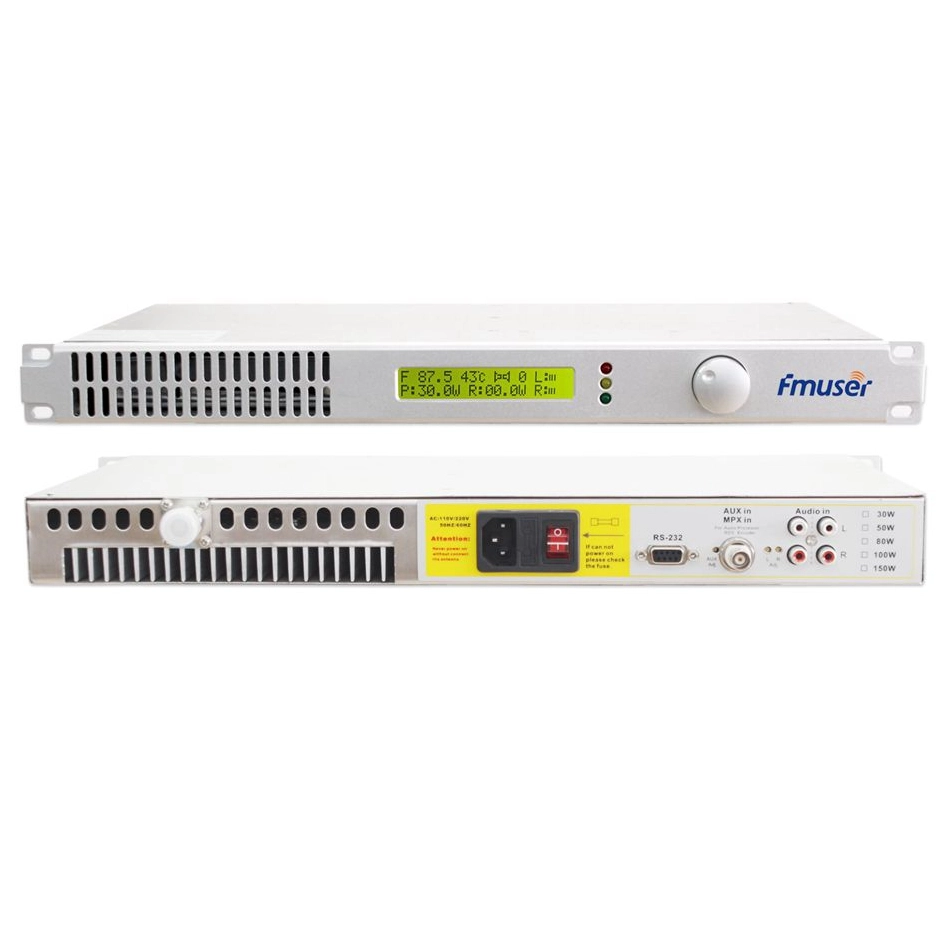
Trasmettitur FM ta 'Qawwa Medju
Trasmettituri FM ta 'qawwa medja huma l-aktar komunement użati fix-xandir bir-radju u f'sistemi ta' komunikazzjoni fuq skala kbira u b'ħafna siti. Jintużaw ukoll f'sistemi ta 'komunikazzjoni minn punt għal punt, bħal netwerks tar-radju fil-bini, netwerks ċellulari, u sistemi ta' monitoraġġ mill-bogħod. Dawn it-trasmettituri jintużaw ukoll fir-radju tad-dilettanti, komunikazzjonijiet tal-baħar, u anke f'komunikazzjonijiet militari. L-applikazzjonijiet l-aktar komuni ta 'trasmettituri FM ta' qawwa medja jinkludu xandir bir-radju, sistemi ta 'komunikazzjoni fuq skala kbira, sistemi ta' komunikazzjoni minn punt għal punt, radju dilettanti, komunikazzjonijiet marittimi u komunikazzjonijiet militari.
-
![FMUSER 2U Economic FM Transmitter 1000 Watt FU-1000C for FM Radio Station]()
FMUSER 2U Ekonomiku FM Trasmettitur 1000 Watt FU-1000C għall-istazzjon tar-radju FM
Prezz (USD): Itlob għal kwotazzjoni
Mibjugħa: 42
-
![FMUSER 2U 300W FM Transmitter FSN-350T ( Max. Adjustable Output 350 Watts) for FM Radio Station]()
Prezz (USD): 1,499
Mibjugħa: 151
-
![FMUSER Compact 2U 600 Watt FM Transmitter FSN-600T for FM Radio Station]()
FMUSER Compact 2U 600 Watt FM Trasmettitur FSN-600T għal Stazzjon tar-Radju FM
Prezz (USD): 2,269
Mibjugħa: 41
-
![FMUSER 2U Compact 1000W FM Transmitter FSN-1000T for FM Radio Station]()
FMUSER 2U Compact 1000W FM Trasmettitur FSN-1000T għal Stazzjon tar-Radju FM
Prezz (USD): 3,169
Mibjugħa: 137
-
![FMUSER FSN-1500T DSP Rack 1500 Watt FM transmitter Compact Design with Touch Screen for FM radio station]()
Prezz (USD): 3,769
Mibjugħa: 123
-
![FMUSER FU-1000D 2U 1KW FM Transmitter For FM Radio Station]()
-
![FMUSER FU618F Professional 100 Watt FM Transmitter 2U Rack Mounted for FM Radio Station]()
FMUSER FU618F Professjonali 100 Watt FM Trasmettitur 2U Rack Mmuntat għall-istazzjon tar-radju FM
Prezz (USD): 2407
Mibjugħa: 67
-
![FMUSER FMT5.0-150H 150W FM Radio Broadcast Transmitter]()
FMUSER FMT5.0-150H 150W Trasmettitur tax-Xandir tar-Radju FM
Prezz (USD): 1029
Mibjugħa: 20
L-aħħar verżjoni tat-trasmettitur tar-radju 150W FM FMT5.0-150H, li tadotta kunċett ta 'disinn ta' stil sempliċi. Tintegra l-eċitatur tat-trasmettitur stereo 50W FM, amplifikatur tal-qawwa, filtru tal-output, u provvista ta 'enerġija li tiswiċċja f'każ standard għoli ta' 1-il pulzier 19U, tnaqqas il-kejbils ta 'konnessjoni bejn il-komponenti, hija ħafna aktar affidabbli, faċli biex topera meta mqabbla ma' FM oħra. Trasmettituri tax-xandir.
-
![FMUSER FU618F Professional 300 W FM Transmitter 2U Rack Mounted for FM Radio Station]()
FMUSER FU618F Professjonali 300 W FM Trasmettitur 2U Rack Mmuntat għall-istazzjon tar-radju FM
Prezz (USD): 3194
Mibjugħa: 78
-
![FMUSER FU618F Professional 500 Watt FM Transmitter 2U Rack Mounted for FM Radio Station]()
FMUSER FU618F Professjonali 500 Watt FM Trasmettitur 2U Rack Mmuntat għall-istazzjon tar-radju FM
Prezz (USD): 3755
Mibjugħa: 37
-
![FMUSER Professional 1KW FM Transmitter 2U Rack Mounted FU618F for FM Radio Station]()
FMUSER Professjonali 1KW FM Transmitter 2U Rack Mmuntat FU618F għal Stazzjon tar-Radju FM
Prezz (USD): 5,304
Mibjugħa: 45
-
![Solid-state 1KW FM Transmitter FMUSER FU618F for FM Radio Station]()
Trasmettitur FM fi stat solidu 1KW FMUSER FU618F għall-istazzjon tar-radju FM
Prezz (USD): 7,298
Mibjugħa: 29
-
![FMUSER 100Watt FM Transmitter for FM Radio Broadcast Station FSN-100B]()
Trasmettitur FM FMUSER 100Watt għall-istazzjon tax-xandir tar-radju FM FSN-100B
Prezz (USD): 869
Mibjugħa: 22
- X'inhu trasmettitur FM ta 'qawwa medja?
- Trasmettitur FM ta 'qawwa medja huwa apparat elettroniku li huwa ddisinjat biex ixandar sinjali tar-radju minn studio għal żona lokali. Jintuża biex ixxandar programmi tar-radju bħal mużika, aħbarijiet, sports u talk shows. Is-sinonimu tiegħu huwa trasmettitur tax-xandir.
- Kif tuża trasmettitur FM ta 'qawwa medja fi stazzjon tar-radju?
- 1. Waħħal it-trasmettitur, l-antenna u l-provvista tal-enerġija.
2. Installa s-softwer meħtieġ għall-ipproċessar u t-trażmissjoni tal-awdjo fuq il-kompjuter.
3. Qabbad il-kompjuter mat-trasmettitur, u żgura li s-sinjal tal-awdjo huwa preżenti fuq it-trasmettitur.
4. Ittestja s-sinjal tax-xandir u s-sistema tal-antenna biex tiżgura riċeviment ta 'kwalità tajba.
5. Intuna t-trasmettitur għall-frekwenza mixtieqa u aġġusta l-output tal-enerġija kif xieraq.
6. Ittestja s-sinjal tax-xandir biex tiżgura li jilħaq il-kwalità tax-xandir mixtieqa.
7. Immonitorja s-sinjal tax-xandir għal kwalunkwe sinjal ta 'interferenza jew storbju.
8. Żgura li s-sinjal tax-xandir jikkonforma mar-regolamenti FCC applikabbli.
Problemi li għandhom jiġu evitati jinkludu:
- Interferenza minn stazzjonijiet tar-radju oħra
- Kwalità tal-awdjo fqira minħabba proċessar jew tagħmir mhux korrett tas-sinjal
- Qbiż tal-limiti ta' qawwa permissibbli mill-FCC
- Is-sħana żejda tat-trasmettitur minħabba użu eċċessiv
- Kif jaħdem trasmettitur FM ta 'qawwa medja?
- Trasmettitur FM ta 'qawwa medja jaħdem billi jieħu s-sinjal tal-awdjo mill-istudjo ta' stazzjon tar-radju u jikkonvertih f'sinjal tar-radju ta 'frekwenza għolja. Is-sinjal imbagħad jiġi amplifikat u mxandar minn antenna. It-trasmettitur huwa konness ma 'riċevitur fl-antenna, li jikkonverti s-sinjal lura f'sinjal awdjo li jista' jiġi trażmess fuq l-arja. L-output tal-qawwa tat-trasmettitur jiddetermina l-firxa tas-sinjal tax-xandir.
- Għaliex trasmettitur FM ta 'qawwa medja huwa importanti għal stazzjon tar-radju?
- Trasmettitur FM ta 'qawwa medja huwa importanti għaliex jista' jilħaq numru akbar ta 'semmiegħa minn trasmettitur ta' qawwa baxxa. Huwa meħtieġ għal stazzjon tar-radju tax-xandir għax iżid il-firxa tal-istazzjon u b’hekk jippermetti li aktar nies jisimgħu x-xandir tal-istazzjon.
- X'inhuma l-aktar qawwa tal-ħruġ li tidher ta 'trasmettitur FM ta' qawwa medja, u sa fejn jistgħu jkopru?
- L-aktar qawwa tal-ħruġ li tidher ta 'trasmettitur FM ta' qawwa medja hija tipikament bejn 100-500 watts. Dan it-tip ta 'trasmettitur tipikament ikollu firxa ta' xandir sa 40-50 mil, skont it-terren u l-għoli tal-antenna.
- Kif tibni pass pass stazzjon tar-radju FM komplut b'trasmettitur FM ta' qawwa medja?
- 1. Agħżel post xieraq għat-trasmettitur. Is-sit għandu jkun ħieles minn ostruzzjonijiet u 'l bogħod minn żoni residenzjali.
2. Ixtri t-tagħmir meħtieġ, bħat-trasmettitur FM ta 'qawwa medja, antenna, linja ta' trasmissjoni, mikrofonu, mixer awdjo, eċċ.
3. Installa l-antenna fuq arblu, u qabbadha mat-trasmettitur billi tuża l-linja ta 'trażmissjoni.
4. Qabbad il-mixer tal-awdjo mat-trasmettitur billi tuża l-kejbils xierqa.
5. Kun żgur li kwalunkwe filtri u amplifikaturi meħtieġa huma installati u konnessi b'mod korrett.
6. Intuna t-trasmettitur għall-frekwenza mixtieqa u aġġusta l-qawwa tal-ħruġ.
7. Waħħal il-mixer tal-awdjo u rrotta l-mikrofonu u kwalunkwe sors tal-awdjo ieħor għalih.
8. Agħmel kwalunkwe aġġustamenti meħtieġa għall-awdjo u ttrasmettih lit-trasmettitur.
9. Tissorvelja s-sinjal trażmess biex tiżgura li l-kwalità tal-ħoss hija tajba.
10. Immonitorja l-livelli tal-qawwa u agħmel kwalunkwe aġġustamenti meħtieġa.
11. Iċċekkja regolarment għal kwalunkwe interferenza jew sorsi ta 'interferenza oħra.
12. Żomm it-tagħmir u ċċekkja għal xi ħsarat jew problemi.
- Kemm jista 'jkopri trasmettitur FM ta' qawwa medja?
- Trasmettitur FM ta 'qawwa medja jista' tipikament ikopri distanza sa 30 mil (48 km).
- X'jiddetermina l-kopertura ta 'trasmettitur FM ta' qawwa medja u għaliex?
- Il-kopertura ta 'trasmettitur FM ta' qawwa medja hija determinata mill-għoli tal-antenna, it-tip tal-antenna, u t-terren ġeografiku. L-għoli tal-antenna u t-tip tal-antenna jiddeterminaw il-kapaċità tat-trasmettitur li jibgħat sinjal f'żona wiesgħa. It-terren ġeografiku (bħal għoljiet, muntanji, jew bini) jista 'jimblokka jew ixerred is-sinjal, u jnaqqas iż-żona ta' kopertura.
- Kif ittejjeb il-kopertura ta 'trasmettitur FM ta' qawwa medja?
- 1. Ottimizza s-Sistema ta 'l-Antenna tat-Trasmettitur: Kun żgur li l-antenna hija sintonizzata sew mal-frekwenza tat-trasmettitur, u li l-antenna tkun ippuntata fid-direzzjoni taż-żona ta' kopertura fil-mira.
2. Żid l-Għoli tal-Antenna: Iż-żieda tal-għoli tal-antenna se żżid iż-żona tal-kopertura. Ipprova ġib l-antenna għoli kemm jista 'jkun.
3. Żid il-Ħruġ tal-Enerġija tat-Trasmettitur: Iż-żieda tal-qawwa tal-ħruġ tat-trasmettitur se żżid ukoll iż-żona ta 'kopertura tagħha. Madankollu, kun konxju tar-regolamenti lokali tal-FCC fir-rigward tal-ħruġ massimu ta 'enerġija ta' trasmettitur.
4. Żid Trasmettituri Addizzjonali: Iż-żieda ta 'trasmettituri addizzjonali tgħin biex tiżdied iż-żona ta' kopertura billi tuża l-istess frekwenza.
5. Uża Antenni Multipli: Installa antenni multipli f'postijiet differenti biex tkopri żona akbar.
6. Uża Żoni ta 'Riflessjoni: Ipprova jsib l-antenna tiegħek f'żoni fejn hemm żoni ta' riflessjoni naturali jew magħmula mill-bniedem bħal għoljiet, bini, jew korpi ta 'ilma. Dawn jistgħu jgħinu biex jirriflettu s-sinjal, iżidu ż-żona ta 'trażmissjoni.
7. Żid in-Numru ta 'Trażmettituri: Żid in-numru ta' trasmettituri biex tippermetti firxa ta 'trażmissjoni aktar effiċjenti.
8. Ittejjeb il-Kwalità tal-Linja ta 'Trażmissjoni: Kun żgur li l-linji ta' trasmissjoni huma f'kondizzjoni tajba u ħielsa minn kwalunkwe difett.
9. Mexxi t-Trasmettitur f'Post Ottimi: Mexxi t-trasmettitur f'post ottimali li jkun ħieles minn kwalunkwe ostakolu li jista' jimblokka jew idgħajjef is-sinjal.
10. Ikkuntattja l-Uffiċċju Lokali tal-FCC tiegħek: Ikkuntattja l-uffiċċju lokali tal-FCC tiegħek biex tiżgura li tkun konformi ma' kwalunkwe regolament lokali.
- Kemm hemm tipi ta 'trasmettituri FM ta' qawwa medja?
- Hemm tliet tipi ewlenin ta 'trasmettituri FM ta' qawwa medja: analogi, diġitali u ibridi. Kull tip joffri vantaġġi u żvantaġġi distinti.
Trasmettituri analogi huma l-eqdem u l-aktar affidabbli. Huma sempliċi biex jiġu installati u joperaw, u ġeneralment huma aktar affordabbli minn mudelli diġitali u ibridi. Madankollu, mhumiex effiċjenti f'termini ta 'effiċjenza tal-enerġija, daqs trasmettituri diġitali u ibridi.
Trasmettituri diġitali huma aktar effiċjenti f'termini ta 'effiċjenza tal-enerġija, iżda jeħtieġu installazzjoni u manutenzjoni aktar ikkumplikata u għalja. Huma għandhom ukoll spejjeż inizjali ogħla, iżda jistgħu joffru aktar karatteristiċi minn trasmettituri analogi.
Trasmettituri ibridi jgħaqqdu l-aħjar kemm analogi kif ukoll diġitali, u joffru l-effiċjenza ta 'trasmettituri diġitali filwaqt li jkunu aktar affidabbli u aktar faċli biex jiġu installati. Madankollu, huma wkoll aktar għaljin u jistgħu jeħtieġu setup u manutenzjoni aktar kumplessi minn trasmettitur analogu.
- Kif tagħżel l-aħjar trasmettituri FM ta 'qawwa medja?
- Meta tagħżel trasmettitur FM ta 'qawwa medja għal stazzjon tar-radju tax-xandir, huwa importanti li tikkunsidra l-fatturi li ġejjin:
1. Prezz - Żgura li l-ispiża tat-trasmettitur tkun fil-baġit tiegħek.
2. Kwalità - Kun żgur li tirriċerka l-kwalità tat-trasmettitur biex tiżgura li hija affidabbli u tissodisfa l-ħtiġijiet tax-xandara.
3. Kopertura - Iċċekkja l-firxa tal-kopertura tat-trasmettitur biex tiżgura li hija adattata għaż-żona tax-xandir.
4. Karatteristiċi - Kun żgur li tirrevedi l-karatteristiċi offruti mit-trasmettitur biex tiddetermina liema huma meħtieġa għax-xandir.
5. Effiċjenza - Irrevedi l-klassifikazzjonijiet tal-effiċjenza tat-trasmettitur biex tiżgura li tissodisfa l-ħtiġijiet tax-xandara.
Billi tikkunsidra dawn il-fatturi, tista 'tieħu deċiżjoni infurmata qabel ma tagħmel ordni finali għat-trasmettitur FM ta' qawwa medja għal stazzjon tar-radju tax-xandir.
- Kif tikkonnettja b'mod korrett trasmettitur FM ta 'qawwa medja?
- Biex tqabbad b'mod korrett trasmettitur FM ta 'qawwa medja fi stazzjon tar-radju tax-xandir, l-ewwel għandek tiżgura li t-trasmettitur ikun imqabbad mal-antenna. L-antenna mbagħad titqabbad mat-trasmettitur permezz tal-kejbil tal-antenna, li għandu jkun ertjat kif suppost. Barra minn hekk, it-trasmettitur għandu jkun imqabbad ma 'sors ta' enerġija, bħal provvista ta 'enerġija ddedikata jew ġeneratur. Wara dan, it-trasmettitur għandu jiġi sintonizzat għall-frekwenza u l-modulazzjoni mixtieqa. Fl-aħħarnett, għandu jkun imqabbad mas-sistema tal-awdjo tal-istazzjon tar-radju tax-xandir u tagħmir ieħor tax-xandir.
- Liema tagħmir ieħor għandi bżonn biex nibda stazzjon tar-radju tax-xandir, apparti trasmettitur FM ta' qawwa medja?
- Minbarra trasmettitur FM ta 'qawwa medja, ser ikollok bżonn antenna, kejbil koassjali, proċessur tal-awdjo, mikrofonu u tagħmir awdjo ieħor, bord tat-taħlit, u riċevitur tas-satellita. Jista 'jkollok bżonn ukoll kompjuter b'softwer għal xandir diġitali, dixx satellitari, u sit tat-trasmettitur. Skont it-tip ta’ xandira, jista’ jkollok bżonn tagħmir jew softwer addizzjonali.
- Kif iżżomm b'mod korrett trasmettitur FM ta 'qawwa medja?
- 1. Iċċekkja s-sistema tat-tkessiħ u kun żgur li qed taħdem sew.
2. Spezzjona l-komponenti RF kollha għal sinjali ta 'xedd u kedd u ibdel kwalunkwe komponenti kif meħtieġ.
3. Naddaf il-filtri tal-arja kollha, iċċekkja għal tnixxijiet, u vverifika li l-fluss tal-arja huwa biżżejjed.
4. Kun żgur li l-provvisti tal-enerġija kollha huma stabbli u fil-medda speċifikata.
5. Iċċekkja s-sistema tal-antenna għal tħaddim tajjeb u kun żgur li l-konnessjonijiet kollha huma siguri.
6. Intuna t-trasmettitur għall-frekwenza mixtieqa u ivverifika li l-qawwa tal-ħruġ tkun f'limiti aċċettabbli.
7. Wettaq testijiet regolari biex tivverifika li t-trasmettitur qed jaħdem b'mod korrett.
8. Tissorvelja t-trasmettitur biex tiżgura li qed taħdem sew.
9. Kun żgur li jiġu segwiti l-protokolli tas-sigurtà kollha u li l-burokrazija kollha meħtieġa tkun mimlija.
- Kif isewwi trasmettitur FM ta 'qawwa medja jekk jonqos milli jaħdem?
- Biex isewwi trasmettitur FM ta 'qawwa medja, ser ikollok bżonn tiċċekkja l-provvista tal-enerġija, l-antenna, l-amplifikatur tal-qawwa u l-komponenti l-oħra kollha tat-trasmettitur. Jekk xi wieħed minn dawn il-komponenti ma jkunx qed jaħdem kif suppost, ikollok bżonn tissostitwihom. Jekk il-problema hija aktar serja, bħall-amplifikatur tal-qawwa ma jaħdimx, jista 'jkollok bżonn tissostitwixxi l-unità kollha. Jekk ikollok bżonn tissostitwixxi xi partijiet miksura fit-trasmettitur FM tiegħek, ser ikollok bżonn tirreferi għall-manwal tas-servizz għall-għamla u l-mudell speċifiku tat-trasmettitur tiegħek. Il-manwal tas-servizz se jipprovdi struzzjonijiet speċifiċi dwar kif jissostitwixxu l-partijiet miksura.
- X'inhi l-istruttura bażika ta 'trasmettitur FM ta' qawwa medja?
- L-istruttura bażika ta 'trasmettitur FM ta' qawwa medja tinkludi antenna, amplifikatur tal-qawwa, modulatur, oxxillatur RF, u exciter. L-antenna hija l-istruttura li tirradja s-sinjal 'il barra, filwaqt li l-amplifikatur tal-qawwa huwa responsabbli biex jamplifika s-sinjal. Il-modulatur huwa dak li jikkodifika s-sinjal tal-awdjo mas-sinjal FM, filwaqt li l-oxxillatur RF jipprovdi l-mewġa tal-ġarr. L-exciter huwa responsabbli biex jipproduċi s-sinjal li jmur għall-amplifikatur tal-qawwa. Dawn l-istrutturi kollha huma meħtieġa biex it-trasmettitur jiffunzjona b'mod normali u huma integrali għall-prestazzjoni u l-attributi tiegħu. Mingħajr l-ebda waħda minn dawn l-istrutturi, it-trasmettitur ma jkunx jista 'jaħdem b'mod normali.
- Min għandu jiġi assenjat biex jimmaniġġja drive in FM transmitter?
- Il-persuna assenjata biex timmaniġġja trasmettitur FM ta 'qawwa medja għandha idealment tkun tekniku jew inġinier b'esperjenza b'fehim tajjeb tas-sistemi elettroniċi, tagħmir tax-xandir bir-radju, u regolamenti tal-FCC. Għandhom ukoll ikollhom ħiliet qawwija għas-soluzzjoni tal-problemi u l-komunikazzjoni, kif ukoll għarfien tajjeb tal-istandards tal-industrija u l-prattiki tas-sikurezza.
- Kif inti?
- jien tajjeb
IKKUNTATJANA


GRUPP INTERNAZZJONALI FMUSER LIMITED.
Aħna dejjem nipprovdu lill-klijenti tagħna prodotti affidabbli u servizzi meqjusa.
Jekk tixtieq iżżomm kuntatt magħna direttament, jekk jogħġbok mur fuq Ikkuntatjana
